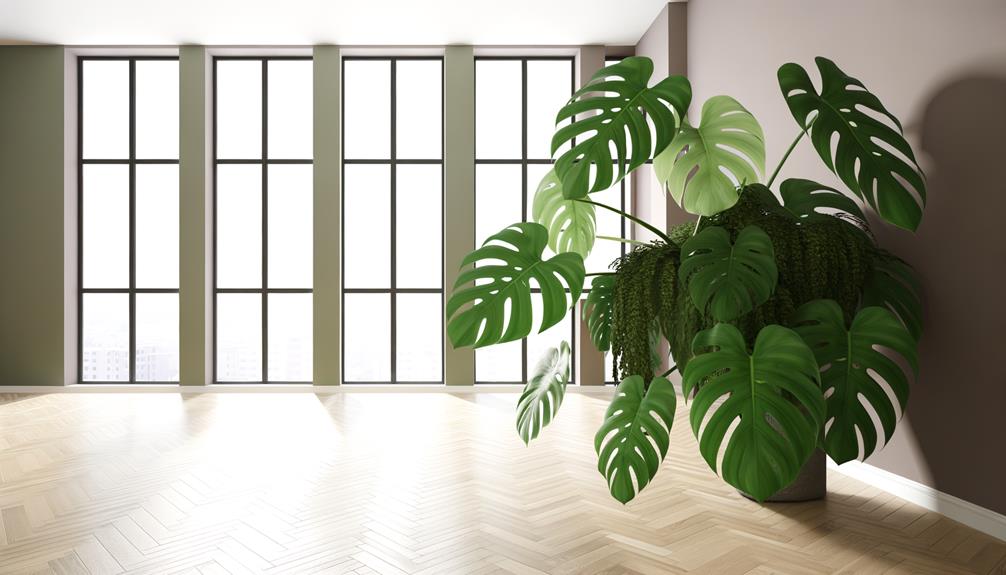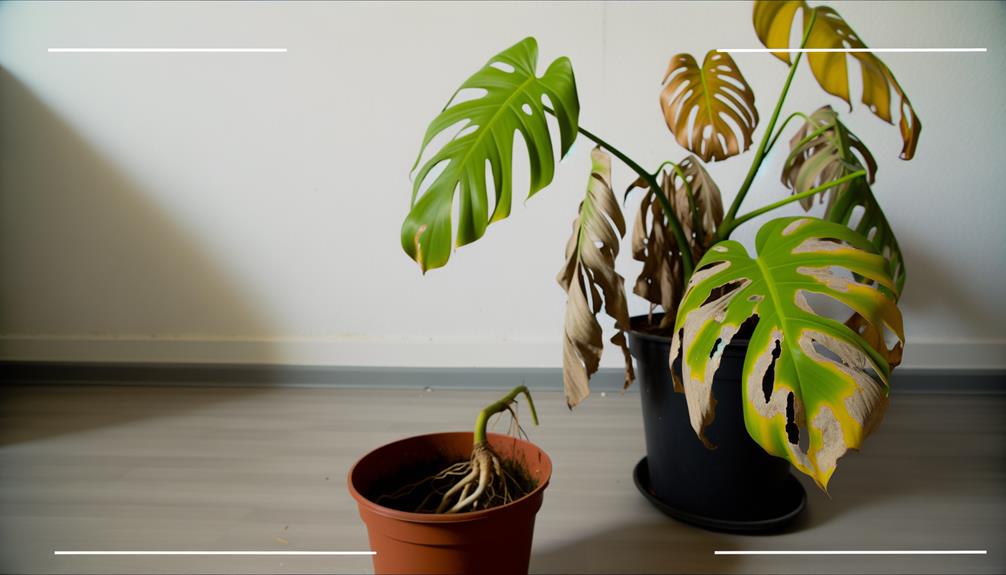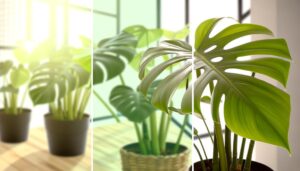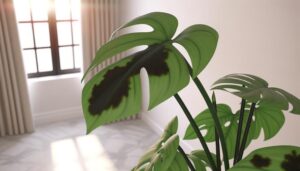How Big Do Monstera Deliciosa Grow Indoors?
Monstera deliciosa, commonly known as the Swiss Cheese Plant, can reach heights of up to 2.4 meters (8 feet) indoors under ideal conditions, characterized by bright, indirect sunlight and a temperature range of 18-27°C. The fenestrated leaves can extend up to 90 centimeters (3 feet) across.
This species thrives in a well-draining soil mix composed of 40% peat moss, 30% perlite, and 30% pine bark fines, and requires consistent soil moisture without waterlogging. Proper watering every 7-10 days and ensuring 60-70% relative humidity are essential.
Adjusting these factors strategically fosters healthier growth and greater dimensions. Discover more detailed cultivation strategies ahead.

Key Takeaways
- Monstera Deliciosa can grow up to 2.4 meters (8 feet) indoors under optimal conditions.
- Indoor growth is influenced by bright, indirect light and proper watering practices.
- Large fenestrated leaves can reach up to 1 meter (3.3 feet) in diameter.
- Consistent humidity levels of 60-70% support healthy growth.
- Pruning and rotating the plant ensure even light distribution and robust development.
Natural Growth Patterns

In its natural habitat, Monstera deliciosa exhibits a climbing growth pattern, utilizing aerial roots to anchor itself to trees and other vertical surfaces. This epiphytic vine thrives in the tropical rainforests of Central and South America, typically ascending to heights of up to 20 meters (65 feet).
The plant's large, fenestrated leaves can reach dimensions of 1 meter (3.3 feet) in diameter. These perforations are hypothesized to aid in the passage of light and rainwater, optimizing photosynthesis and hydration.
Monstera deliciosa's robust root system draws nutrients from decomposing organic matter, while its aerial roots absorb moisture from the humid air. This natural climbing behavior and physiological adaptations allow Monstera deliciosa to flourish in its densely vegetated, competitive environment.
Ideal Indoor Conditions
To optimize Monstera Deliciosa growth indoors, it is essential to maintain specific light and temperature conditions, alongside appropriate humidity and watering practices.
The plant thrives in bright, indirect sunlight and temperatures ranging from 18°C to 27°C.
Additionally, maintaining a relative humidity of 60-70% and ensuring consistent soil moisture without waterlogging are vital for healthy development.
Light and Temperature
Ideal growth of Monstera deliciosa indoors requires light levels of 200-500 foot-candles and temperatures between 65-75°F (18-24°C). Monstera deliciosa thrives in bright, indirect light, ideally avoiding direct sunlight which can cause leaf burn. The plant's photosynthetic efficiency is optimized within this specific light range, ensuring robust growth.
Temperature is another critical factor. The Monstera deliciosa prefers a stable environment that mimics its native tropical habitat. Sudden temperature fluctuations should be avoided to prevent stress on the plant.
| Parameter | Ideal Range |
|---|---|
| Light Levels | 200-500 foot-candles |
| Temperature | 65-75°F (18-24°C) |
| Light Type | Bright, indirect |
| Avoidance | Direct sunlight |
Understanding these conditions can greatly enhance the health and size of indoor Monstera deliciosa.
Humidity and Watering
Maintaining ideal moisture levels between 60-80% and providing consistent watering practices are essential for the vigorous growth of Monstera deliciosa indoors. Elevated moisture levels facilitate efficient transpiration and nutrient absorption, critical for foliar development. Utilize a hygrometer to monitor ambient moisture and employ a humidifier if necessary.
Watering should guarantee the substrate remains consistently damp but not waterlogged. Employ a soil moisture meter to determine the best time for irrigation, typically when the top 2-3 inches of soil are dry. Use tepid, dechlorinated water to prevent root shock and mitigate chlorosis.
Additionally, consider employing a well-draining soil mix containing perlite or orchid bark to enhance aeration and prevent root rot, ensuring a healthy root system.
Light Requirements

Ideal growth of Monstera deliciosa indoors requires exposure to bright, indirect light, ideally between 10,000 and 20,000 lux. Inadequate light levels can lead to etiolation, characterized by elongated stems and sparse foliage. Conversely, excessive direct sunlight can cause leaf burn, appearing as brown, crispy edges.
| Light Intensity (lux) | Growth Outcome |
|---|---|
| < 10,000 | Slow growth; potential etiolation |
| 10,000 – 20,000 | Optimum growth; healthy foliage |
| > 20,000 | Risk of leaf burn; damaged foliage |
Using a light meter can help monitor these levels accurately. Placing the plant near east or west-facing windows, filtered by sheer curtains, can help achieve the ideal light conditions. Artificial grow lights can supplement natural light, ensuring consistent photoperiods.
Watering Schedule
An efficient watering schedule for Monstera deliciosa involves maintaining soil moisture at a level where the top 2-3 centimeters are allowed to dry out between waterings. This ensures ideal hydration while preventing root rot, a common issue from overwatering.
Utilize a moisture meter for precise readings, ensuring soil moisture levels remain within the best range. Typically, watering once every 7-10 days suffices, but adjustments are necessary based on environmental conditions such as temperature and humidity.
During the plant's active growth phase in spring and summer, more frequent watering may be required. Conversely, reduce watering frequency during the plant's dormancy in autumn and winter.
Monitoring and adjusting based on these parameters will support healthy Monstera deliciosa growth indoors.
Soil and Potting Mix

Selecting the right soil and potting mix for Monstera deliciosa is necessary to providing the needed aeration, drainage, and nutrient availability for best indoor growth. An ideal mix consists of 40% peat moss, 30% perlite, and 30% pine bark fines. This combination ensures sufficient moisture retention while preventing waterlogging, which can lead to root rot.
The pH level should be slightly acidic, ranging between 5.5 and 6.5. Incorporating organic matter, such as compost or worm castings, can improve nutrient content. Additionally, a well-draining pot with a diameter approximately 2 inches larger than the root ball is recommended to encourage healthy root expansion.
Regular monitoring of soil conditions is vital for maintaining an environment conducive to strong growth.
Pruning and Maintenance
Regular trimming and upkeep are crucial for promoting strong growth and preventing potential issues in Monstera deliciosa grown indoors. Trimming should be carried out using sterilized tools to avoid pathogen transmission.
Remove any yellowing, damaged, or dead leaves to direct energy towards healthy growth. Trim aerial roots that extend beyond the support structure, but make sure they remain at least 3-5 cm long to aid nutrient absorption.
Carefully trim excess vines to maintain desired plant size, ideally during the growing season (spring to early autumn). Inspect for pests and diseases regularly, and wipe leaves with a damp cloth to remove dust, facilitating the best possible photosynthesis.
Common Growth Challenges

When cultivating Monstera deliciosa indoors, several growth challenges are frequently encountered, including inadequate light exposure, overwatering issues, and susceptibility to pests and diseases.
Insufficient light, typically less than 1000 lux, can hinder photosynthesis and reduce leaf fenestration.
Overwatering can lead to root rot, while pests such as spider mites and diseases like powdery mildew pose additional threats to plant health.
Inadequate Light Exposure
Insufficient light exposure is a prevalent issue that can greatly impede the growth and health of Monstera Deliciosa when cultivated indoors. These tropical plants require a minimum of 1000 lux (approximately 100 foot-candles) for best photosynthetic activity.
When exposed to subpar lighting conditions, typically below 500 lux, the plant exhibits etiolation, characterized by elongated, spindly stems, and smaller, less fenestrated leaves. Additionally, inadequate light can result in chlorosis, where leaves become pale due to insufficient chlorophyll production.
To mitigate this, it is advisable to position Monstera Deliciosa within 1-2 meters of a south or east-facing window, or supplement with artificial grow lights, ensuring a photoperiod of 12-16 hours daily, mimicking their native tropical environment.
Overwatering Issues
In addition to light requirements, improper watering practices, particularly overwatering, pose a significant threat to the health of Monstera Deliciosa when grown indoors. Overwatering leads to root rot, a condition where the roots become waterlogged and start to decay due to anaerobic conditions. Symptoms include yellowing leaves, wilting, and stunted growth.
For peak health, the potting medium should have excellent drainage properties, allowing excess water to escape. The recommended watering frequency is once the top 2-3 centimeters (approximately 0.8-1.2 inches) of soil becomes dry. Utilize well-draining soil mixes containing perlite or orchid bark to enhance aeration.
Monitoring moisture levels using a soil moisture meter can provide more precise watering control, averting potential overwatering complications effectively.
Pests and Diseases
A variety of pests and diseases can afflict Monstera Deliciosa, impeding its growth and overall health. Common pests include spider mites (Tetranychidae), mealybugs (Pseudococcidae), and scale insects (Coccoidea), which can cause chlorosis, stunted growth, and leaf drop. Regular inspection using a magnifying glass can help detect early infestations.
Diseases such as bacterial leaf spot (Xanthomonas campestris) and root rot (Pythium spp.) are often linked to excessive moisture and poor drainage. Symptoms include water-soaked lesions, wilting, and browning of foliage. Implementing integrated pest management (IPM) strategies, such as maintaining ideal humidity levels (40-60%), ensuring proper air circulation, and using systemic insecticides, can mitigate these issues.
Prompt intervention is essential for maintaining plant vigor and achieving excellent indoor growth.
Seasonal Growth Variations
Seasonal growth variations in Monstera deliciosa are influenced by fluctuations in light intensity, temperature, and humidity levels throughout the year. During the spring and summer, increased daylight hours (approximately 12-16 hours), temperatures averaging 21-27°C, and elevated humidity (60-80%) facilitate vigorous growth. Conversely, in autumn and winter, reduced light exposure (8-10 hours), cooler temperatures (15-20°C), and lower humidity (40-60%) slow the plant's growth rate. Detailed observations are presented below:
| Season | Light Intensity (hours/day) | Temperature (°C) | Humidity (%) |
|---|---|---|---|
| Spring | 12-16 | 21-24 | 60-70 |
| Summer | 14-16 | 24-27 | 70-80 |
| Autumn | 10-12 | 18-21 | 50-60 |
| Winter | 8-10 | 15-20 | 40-50 |
These parameters are essential for understanding Monstera deliciosa's seasonal growth dynamics.
Encouraging Maximum Growth

To encourage maximum expansion in Monstera deliciosa, it is essential to optimize environmental conditions, including light, temperature, humidity, and soil nutrients.
Providing bright, indirect light at 10,000-20,000 lux is vital. Maintain ambient temperatures between 18-27°C (65-80°F) and relative humidity levels of 60-80%.
Soil should be well-draining with a pH of 5.5-7.0, enriched with organic matter. Regularly apply balanced, water-soluble fertilizers (N-P-K ratio 20-20-20) during the growing season.
Pruning to remove dead or yellowing leaves promotes healthier growth. Additionally, rotating the plant periodically ensures even light distribution.
Employing these specific conditions fosters prime growth and vigor, allowing Monstera deliciosa to achieve significant indoor heights of up to 2.4 meters (8 feet).
Conclusion
Monstera deliciosa, when provided with ideal indoor conditions, can achieve substantial growth, similar to a well-tended bonsai tree reaching impressive proportions within its miniature confines. Research indicates that these plants can grow up to 3 meters in height indoors.
Ensuring sufficient light, proper watering, and suitable soil mix, alongside regular pruning, fosters robust development. However, challenges such as inconsistent light or improper watering can hinder growth, akin to a tree struggling to thrive in poor soil.






